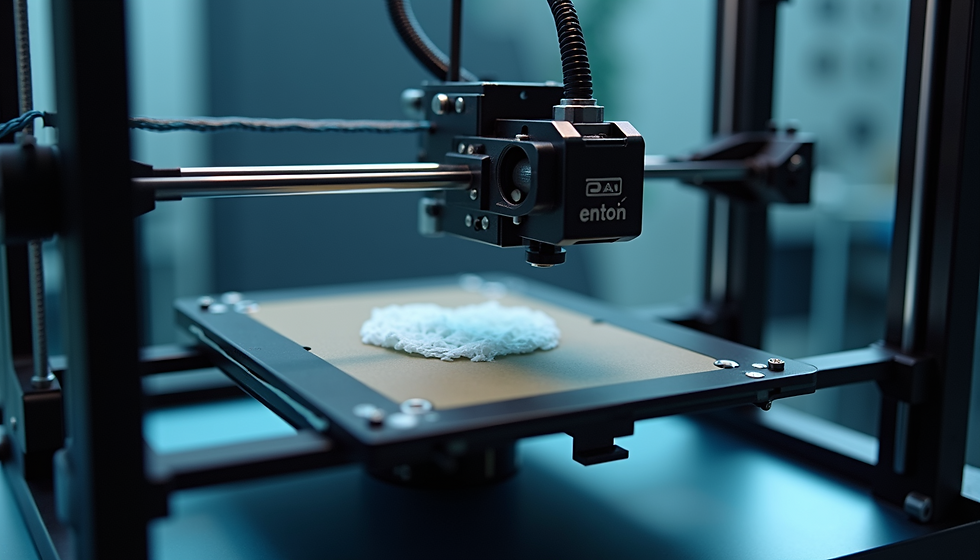Understanding the Basics of 3D Printing File Formats
- Mesh Mayhem
- Apr 30
- 4 min read
Updated: Jun 23
3D printing is a revolutionary technology that has transformed various industries, from manufacturing to healthcare. One key aspect that underpins successful 3D printing is understanding the different file formats that are used. This post will guide you through the essentials of 3D printing file formats, helping you learn how to select the right one for your projects.
3D Printing Files
3D printing relies on digital models represented in specific file formats. Each format serves a unique purpose and has distinct features that influence how well a printer can reproduce the model. The most common file formats include STL, OBJ, AMF, 3MF, and G-code.
STL Files: The Standard Format
Standard Tessellation Language (STL) is perhaps the most recognized file format in 3D printing. It was developed in the 1980s for CAD software and is widely used for 3D printing due to its simplicity. STL files describe only the surface geometry of a 3D object using a series of triangular facets.

While STL files are simple and easy to use, they have their downsides. They do not support color or texture information and can become quite large if the model has many triangles. Despite this, STL remains a favorite among hobbyists and professionals alike for its compatibility across various software and machines.
OBJ Files: Adding More Detail
The OBJ file format is another popular choice, known for its ability to include complex geometry, texture mapping, and color. Unlike STL, OBJ files support both 3D models and their surface materials, making them ideal for projects that require visual detail and aesthetics.

One significant advantage of OBJ files is their ability to manage large, complex models without significantly increasing file size. This makes them particularly valuable for artists and designers working on intricate designs. By using the OBJ format, creators can ensure that their 3D prints not only function well but also look great.
Can You 3D Print a Mesh from Rhino?
Rhino is a powerful 3D modeling software known for its versatility and precision. You can absolutely 3D print a mesh created in Rhino; however, the key is to export the model in a compatible format. Both STL and OBJ formats are viable choices for 3D printing meshes from Rhino.
When exporting from Rhino, make sure to check the mesh settings. If the mesh is too dense or too coarse, it may cause issues during the print process. Aim for a balance that maintains detail without overwhelming the software or the printer.
Using the right export settings can mitigate common problems such as flooding or insufficient support structures. Rhino's flexibility allows you to adjust mesh resolution, ensuring your final print meets quality standards.
AMF and 3MF: The New Contenders
As 3D printing technology progresses, newer file formats like Additive Manufacturing File Format (AMF) and 3D Manufacturing Format (3MF) are gaining traction.
AMF was designed to overcome the limitations of STL by supporting advanced features like color, texture, and even multiple materials. This format allows for a more robust representation of complex designs, making it a great option for more comprehensive 3D prints.
3MF is another standard that stands out because it was built specifically for 3D printing workflows. It includes rich metadata and supports features that STL and OBJ do not, such as texture, color, and material usage. The 3MF format streamlines the process for manufacturers and designers alike.
These file formats can significantly enhance the quality and versatility of 3D prints, providing options that help in achieving intricate designs effectively.
G-code: The Printer's Language
G-code is a language used to control 3D printers, detailing the instructions for movement, temperature, and speed. Unlike the other file formats, G-code is generated by slicing software, converting 3D models into a format understandable by printers.
When you prepare a model for printing, slicing software translates the 3D file into a series of G-code commands. These commands tell the printer how to build the object layer by layer. G-code is customizable, allowing users to tweak settings based on their printer model and material.

Understanding G-code is invaluable for anyone serious about 3D printing. Modifying the parameters can lead to better print quality, more efficient material use, and even reduce the risk of print failure.
Choosing the Right Format for Your Project
Now that we've discussed various 3D printing file formats, it's crucial to choose the right one for your project. Here are some considerations:
Project Requirements: If your project demands color and texture, you might want to choose OBJ, AMF, or 3MF. For basic models, STL remains a reliable choice.
Software Compatibility: Ensure that the software you are using supports the file format you choose. For example, if you're working in Rhino, be aware of how to export to your preferred format.
Printer Specifications: Some printers have limitations on the file formats they accept. Check your printer's manual to confirm compatibility.
Post-Processing Needs: If you plan to do further processing or layering, G-code will be essential to your workflow.
By evaluating these aspects, you'll make informed decisions and enhance the chances of successful 3D prints.
Final Thoughts on 3D Printing File Formats
Understanding 3D printing file formats is fundamental for anyone looking to enter or improve in this evolving field. While STL and OBJ are the standards, newer formats like AMF and 3MF provide exciting new features that can enhance your projects. Having a grasp of G-code will further improve your printing capabilities.
For a seamless printing experience, invest time in learning these formats - they are your gateway to exploring the full potential of 3D printing technology. Remember to explore various resources and stay updated. With a little effort, you can navigate the world of 3D printing file formats with confidence.
To dive deeper into this exciting topic and explore more about 3D printing, check out resources like mesh mayhem.




Comments